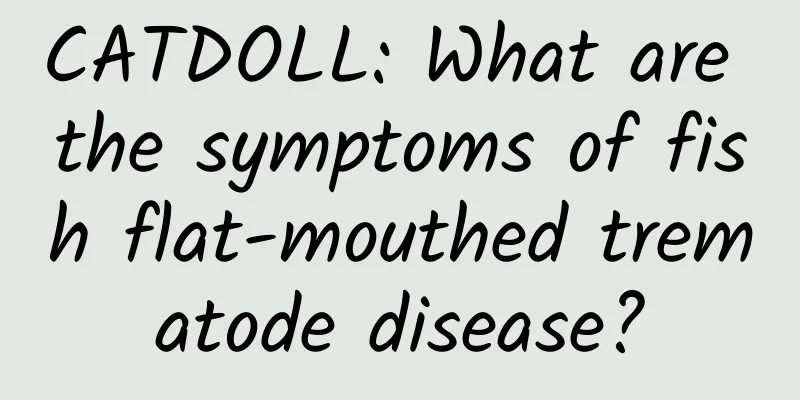CATDOLL : CATDOLL: What are the symptoms of fish flat-mouthed trematode disease?

1. What are the symptoms of fish flat-mouthed trematode disease?Pathogen: The pathogen of heron flat-bent trematode disease is the adult flat-bent trematode, which parasitizes the throat and esophagus of birds of the Ardeidae family. It is beige in color, can make violent leech-like telescopic movements, and is 4-6 mm long and 1.78-2 mm wide. There is a sucker at the front end of the insect body, which is connected to the muscular pharynx below, and then to the bifurcated intestinal blind tube. The two intestinal blind tubes extend to the rear end of the insect body, and in the middle of the extension, they branch out to the side. The abdominal sucker is located in the front quarter of the insect body and is larger than the oral sucker. The excretory duct is on both sides of the insect body, and the excretory sac is small and "V" shaped. The reproductive organs are located in the middle of the body, with two testes with slightly branched outer edges, and an ovary between the two testes. Life history: The adult trematodes of the planustomum parasitize in the throat and esophagus of the heron. When the heron eats fish, the eggs fall from the bird's mouth into the water and hatch directly into miracidia. The miracidia swim in the water and when they encounter the first intermediate host, the snail (Sternbergia sternbergii, Earth Snail), they drill into the snail's body and develop into sporocysts and redia. After two generations of redia, cercariae are produced. The cercariae have eyespots and a forked tail. After escaping from the snail's body, the cercariae swim in the water or float on the water surface. When they encounter fish, they drill into the skin or hide in the muscles, shed their tails, and develop into metacercariae. When the diseased fish is swallowed by a bird, the metacercariae are in the throat or mouth. After 4 days, they develop into adults and begin to ovulate. Prevalence: Herons of all ages can be infected, but are more common between 7 and 30 days old. Insects are rarely found in birds younger than 7 days old and in adult birds. They are more common from March to May each year. Clinical symptoms and hazards: In the throat, base of the tongue, lower jaw and esophagus of the heron, a large number of beige insects resembling grapefruit flesh can be seen tightly attached. The infection ranges from asymptomatic to causing the bird to become listless, with ruffled feathers, reduced luster, pale skin, slow growth, and severely infected birds can even die. Prevention and control methods: Thoroughly remove snails such as radish snails from the ponds (waters) where herons live, and eliminate the intermediate hosts. You can use 0.7 mg/L to spray the entire pond once a day for two consecutive days. Put a grass bundle made of water plants in the downwind part of the fish pond to trap snails. You can pick up the radish snails and other snails attached to the water grass bundles every day, kill them away from the fish pond or bury them in the soil. Do this for a few days in a row, and you will get a certain effect. Prevent herons from eating sick fish infected with metacercariae. Strengthen control from the purchase, processing, and feeding of feed fish. That is, choose feed fish from healthy sources during the purchase process, pay attention to killing pathogens during the processing process, strictly control the feeding process, and remove suspicious fish meat in time. For birds infected with adult insects, use 25 mg/bird mixed feed once a day for two consecutive days, and the effect is better. 2. What is Paragonimiasis?Paragonimiasis is a parasitic disease caused by human infection with Paragonimus, which can be acute or chronic. The trematodes mainly parasitize in the lungs, and patients often show respiratory symptoms, such as coughing and coughing up brown-red sputum; occasionally, they can also parasitize in other tissues and organs, such as the brain, spinal cord, gastrointestinal tract, and abdominal cavity, and produce different clinical symptoms depending on the parasitic site. The treatment of this disease is mainly anti-paragonimiasis and symptomatic treatment. 3. Is Paragonimiasis serious?Paragonimiasis is serious. It mainly parasitizes in human lungs and can also reach the brain and spinal cord, abdominal cavity and subcutaneous tissue to cause corresponding damage. Its clinical manifestations are variable and relatively complicated. Chest symptoms mainly include cough, sputum and chest pain as the first symptoms, as well as brown-red jam-like sputum, often accompanied by repeated hemoptysis. 4. How to prevent liver fluke disease?To prevent liver fluke disease, we must control the source of infection, that is, control the patients found, report the infectious disease card, and promptly treat liver fluke to avoid continued excretion of pathogens containing liver fluke eggs. We must also control the transmission route, that is, pay attention to food hygiene and avoid raw fish and shrimp containing liver fluke metacercariae from entering the human body. 5. How to treat paragonimiasis?Paragonimiasis is a parasitic disease of the lung tissue caused by infection with Paragonimus. Clinically, it is mainly manifested by coughing and coughing up brown-red sputum. The treatment of this disease mainly uses sensitive antibiotics for anti-infection treatment. At the same time, appropriate cough and phlegm treatment can be given. Patients should pay attention to eating high-protein, high-vitamin, light and easily digestible food. 6. What is canine paragonimiasis?Paragonimiasis is also known as lung fluke disease. Because the pathogen is Paragonimiasis debris, it is also called Paragonimiasis. There are many types of Paragonimiasis, the most common of which is Paragonimiasis westermani, which parasitizes the lungs, pleura and trachea of dogs and cats; it is mainly prevalent in Zhejiang, Taiwan and Northeast China. Another type of Paragonimiasis has been found in Guangdong, Sichuan, Jiangxi and Guizhou provinces, which usually parasitizes in subcutaneous nodules and rarely attacks the lungs. 7. What are the symptoms of liver fluke disease?Some patients with liver fluke disease do not have any symptoms. Most patients discover abnormal liver function during physical examinations and larvae clusters during ultrasound examinations. If the patient's condition is serious, there will also be fatigue, pain and distension in the liver area, and digestive tract symptoms such as nausea, aversion to greasy food, and vomiting, and petechiae and ecchymosis will appear on the skin. 8. How to treat liver fluke disease?Treatment is mainly divided into two aspects: 1. Treatment of the pathogen. The preferred drug is praziquantel, which is mainly taken orally. 2. Symptomatic treatment. The treatment plan varies according to the patient's clinical manifestations. For acute schistosomiasis, the main treatment is to reduce fever, replenish fluids, and correct acid-base imbalance and electrolyte disorders. 9. How to treat liver fluke disease?Liver fluke disease is usually treated with drug-based insecticides. From an insecticide perspective, praziquantel is usually used for full and complete treatment, which can achieve good results. However, if there are many parasites in the gallbladder or biliary system, or if early cancer symptoms have been induced, digestive system ERCP technology can be used to complete the treatment of liver fluke disease by removing the parasites and combining drug-based insecticides. The above content is for reference only. For specific medication and treatment, please refer to the doctor's face-to-face consultation. 10. What is schistosomiasis liver disease?Liver fluke disease is Clonorchiasis, a parasitic disease that parasitizes the bile ducts in the human liver. The main sources of infection for this disease are mammals and humans infected with Clonorchis sinensis. People are infected by eating uncooked freshwater fish or shrimp containing Clonorchis sinensis metacercariae. Clinical manifestations include epigastric pain, diarrhea, hepatomegaly, cholangitis, gallstones, cirrhosis, etc. |
<<: CATDOLL: Which fish are suitable for freshwater farming in the north?
>>: CATDOLL: Four major economic fish species? Four major economic marine fish species?
Recommend
How to kill fleas on cats?
How to kill fleas on cats: 1. Putting a flea colla...
The causes and countermeasures of Persian cat hair loss
Reasons and measures for Persian cat hair loss: 1....
CATDOLL: How to keep fireflies alive for a longer time (How to keep fireflies alive for a longer time)
1. What are the conditions for artificially breed...
CATDOLL: How many times a year should I change the water when raising earthworms and cow dung? (How many times a year should I change the water when raising earthworms and cow dung?)
1. Can cow dung be used to raise earthworms? Answ...
CATDOLL: Why do snails give birth directly?
The snail is an ovoviviparous animal with a uniqu...
CATDOLL: How much do you know about the benefits of raising chickens in winter?
The four major problems that chickens are prone t...
CATDOLL: What are the countermeasures for redness and fever on pigs?
What are the countermeasures for redness and feve...
CATDOLL: Why are there horizontal grooves on my nails? Can anyone tell me?
Why are there horizontal grooves on my nails? Can...
CATDOLL: Does kelp need fertilizer during its growth process?
1. Does kelp need fertilizer during its growth pr...
CATDOLL: Expert interpretation: Causes and treatments of leg pain after fever in pigs
Causes of leg pain caused by fever in pigs Pain i...
CATDOLL: How many silver carp fry should be released in 30 mu of land with a water depth of two meters?
If all 30 acres of land are stocked with silver c...
CATDOLL: How much does silk cost per pound in 2020 (How much does silk cost per pound in 2020)
1. Is it true that silk costs 20 yuan per pound? ...
CATDOLL: List of scorpion species
There are many types of scorpions, with more than...
CATDOLL: How much does it cost to raise earthworms?
1. Profit analysis of raising earthworms to feed ...
CATDOLL: What are the personality traits and fate of people born in the Year of the Earth Pig?
Personality traits of people born in the Year of ...









